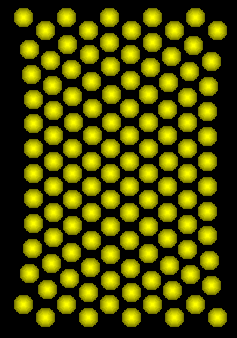
Alex Buchel and I have recently written a paper or two claiming that ``Elastic theory has zero radius of convergence''. What does that mean?

If you take physics in your first year of college, they teach you about Hooke's law:
If you take math in your first year of college, they teach you about infinite series and the radius of convergence. It's easy to guess that Hooke's law is just the first term in an infinite series:
We asked: what is the radius of convergence for nonlinear elastic theory?
The radius of convergence of a series is the distance to the first singularity. In physical terms, we are asking how much we can stretch or compress a piece of material before something dramatic happens. One obvious choice for a dramatic event would be fracture! Stretch a material too far, and it will break in two.
How far do you have to pull to break a piece of steel, or glass? The engineers have studied this problem in great detail - they measure the toughness of steel by taking a bunch of steel beams and pulling on them until they fracture. However, the beams don't all fracture at exactly the same force: different beams have different little flaws and microcracks. They don't all break right away: if the engineers wait longer a few more beams break, and their toughness measurement becomes a bit smaller. Also, the toughness they measure depends very slightly on the size of the beam: a beam with twice the length will break slightly earlier on the average, because it has twice as much chance to have a flaw.
So, suppose we insist on a perfect answer. How much can we stretch a huge hunk of steel (infinite in size), waiting an infinite time, without having it break in two? We'll allow the steel to be perfect (no flaws), but we'll allow the atoms in the steel to vibrate and rearrange (because of temperature) to find their lowest energy state.
If we start with a cube of steel L x L x L in size, and stretch it by a fractional amount e = X/L, how much energy does it take? Clearly, it takes a certain amount of energy per unit volume to stretch the steel, so this energy must grow like L3. (If we limit ourselves to small strains e so we can use Hooke's law, the energy is Y e2 L3/2, where Y = K/L is Young's modulus, sort of the spring constant K for strain per unit volume.) If we break the cube in two, we have to cut all the chemical bonds on the fracture surface: since the broken bonds cover a L x L area, this energy will be some energy per unit area times L2. Because the area of broken bonds increases more slowly than the volume of the cube, no matter how small the strain e = X/L is, large enough cubes will prefer to break! If we plug in numbers for a typical material, it takes a few eV to break a bond, and a few eV per atom to stretch the material by a factor of two (X=L), so a one meter cube would prefer to break after being stretched about 0.002 centimeters. (In American units, a cubic foot stretched 0.0004 inches will have lower energy broken into two pieces.) The bigger the hunk, the smaller the percentage stretch before it prefers to break. (This does not mean that it will break! What can happen in principle often takes an amazingly long time to happen in practice.)
This means, for our infinite hunk of steel, that as soon as we start stretching it, it can break. If we wait long enough, it will in principle break just from the vibrations of the atoms. The nearest singularity is at zero strain: elastic theory will have zero radius of convergence. We say that it is an asymptotic series.
There are other famous theories with zero radius of convergence. Alex and I didn't just announce our new result: for two dimensional elastic films, we calculated the rate of fracture at small strains, and used it to calculate the nonlinear elastic coefficients KN for large N. (The ratio test works: KN/KN+1 goes as N-1/2, so it goes to zero for big N.) Alex also heroically calculated the prefactors for the rates, calculating the energies of curvy cracks, wiggling cracks, nonlinear elasticity, ...
This research was paid for by THE US GOVERNMENT through the Department of Energy (DOE #DE-FG02-88-ER45364).
James P. Sethna, sethna@lassp.cornell.edu
![]() Statistical Mechanics: Entropy, Order Parameters, and Complexity,
now available at
Oxford University Press
(USA,
Europe).
Statistical Mechanics: Entropy, Order Parameters, and Complexity,
now available at
Oxford University Press
(USA,
Europe).